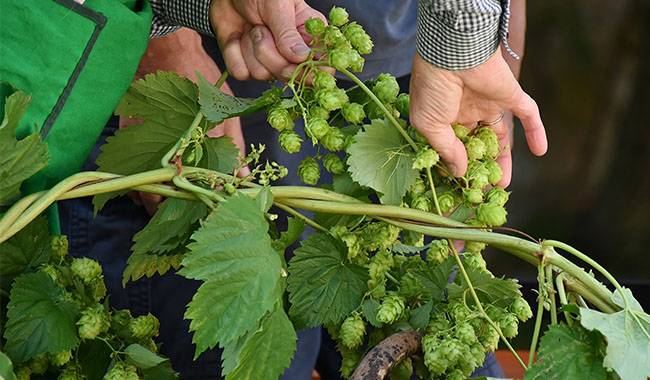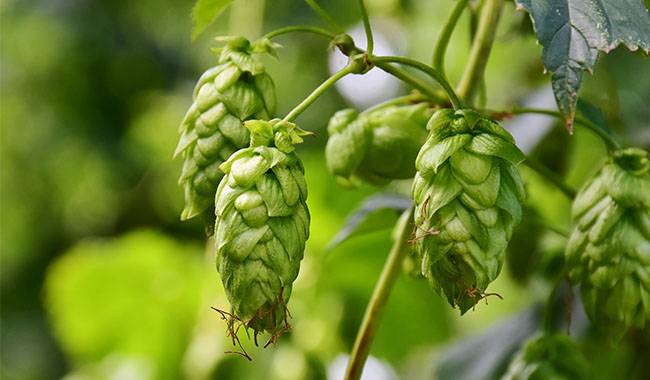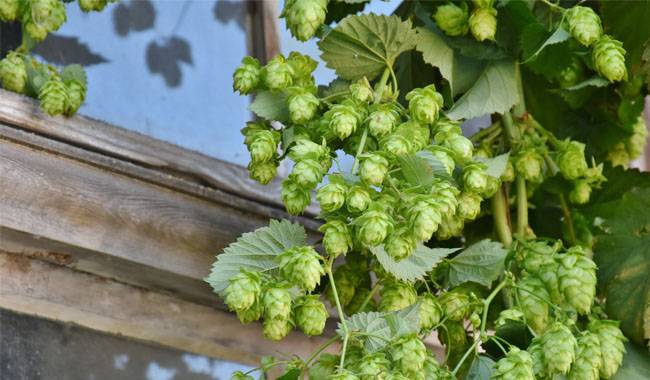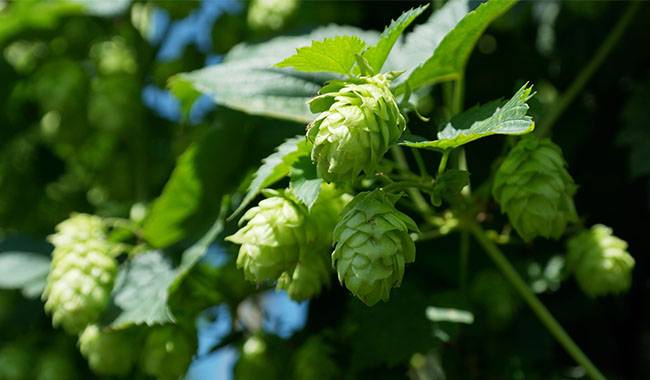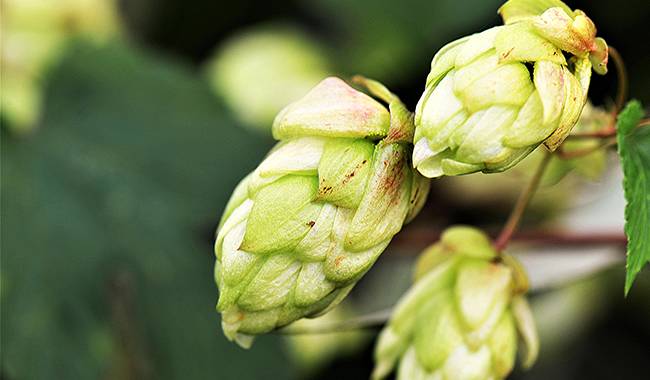
It is known as snakeweed (Latin name: Humulus lupulus), beer snakeweed, curly hops… This powerful and beautiful flower has everything that is useful to mankind.
Hops are revered by many peoples of the world as a symbol of health, greatness, economic strength, prowess, happiness, and longevity.
But many trellis owners are not at all happy about this. Hops tend to grow fast and inhibit the growth of surrounding cultivated plants. But do you really want to get rid of it? Wouldn’t it be better to use its properties for your own benefit?
We will tell you about how to use hops in this article.
BIOLOGICAL CHARACTERISTICS OF COMMON HOPS
Hops (Humulus lupulus) of the Cannabaceae family (Cannabaceae) are found in nature on the moist edges of light forests, on trailing shrubs, and on wet riverbanks. The hop chooses special conditions for itself. Its roots must be in lightly moist and shady soil, and the shoots must be able to rise towards the bright sun, simply by winding clockwise around the stand.
In the garden: Hops, like knotweed or horseradish, quickly invade unfinished areas, crowding out other plants over time and, worse, entering the garden with its neighbors, thus causing resentment.
Liana remains in the same place for 20-30 years.
Hop is a perennial climber with huge rhizomes and many long, horizontal, thin roots. The rhizomes can grow to a height of 33 feet (10 meters) or more. It has a large number of branches for each bud.
The flowers are small, white, unisexual, and lacking in appearance. The female flowers (pistils) are clustered in panicles. Male flowers (stamens) are clustered in small panicles and are shed soon after flowering. Male pollen is blown away by the wind for several kilometers. Flowering begins in mid-summer and the fruit is ripe by the end of August or early September.
The vine produces a large number of flower buds only if it has tall, strong support. The entire plant is covered with (even the veins on the leaves) barbs to prevent it from slipping off the support.
THE MEDICINAL PROPERTIES OF COMMON HOPS
Common hops should not be confused with Japanese hops (Humulus japonicas), which are not medicinal plants and are only used for ornamental purposes.
Common hop is a valuable medicinal plant and is included infamous preparations: Novo-Passit (natural herbal sedative), Corvalol (sedative of herbs), etc.
In ancient manuscripts of the ninth century, the hop is referred to as a medicinal plant (it was used as a cleansing agent and cholagogue) and did not start to be used in brewing until much later.
Its roots and leaves have medicinal value, as do the fruits or stems of Humulus (Lupuli flos) and the separately harvested Lupulinum, U. S. P. (Lupulin).
All parts of the plant contain a unique essential oil, which contains about 230 components. It is this oil that determines the special medicinal properties of this plant. Most of it is contained in the “wild” fruits – from 0.5% to 2%, and in the hops species – 0.3%.
Hops essential oil is used in medicine, pharmacy, cosmetology, as well as in the food industry and cooking. Hops oil is part of the medicine for the treatment of cardiovascular and cerebrovascular diseases, kidney diseases, neurasthenia, sleep disorders.
On the basis of hops oil, the necessary products for the preparation of delicate perfume compositions a
HOPS HARVESTING AND HARVESTING
Common hops are considered by experts to be a poisonous plant and should therefore be treated with caution, especially when harvesting hop berries (it is best to use gloves and protective goggles).
Drowsiness, headaches, and various allergic reactions may occur during the harvesting process. There is even a medical term for “hop picker’s disease”. Prolonged work with cones may result in elevated body temperature, shortness of breath, and depressed moods.
The stems, or cones, should always be harvested as stems. They should only be harvested when dry and windless.
They can also be harvested when the fruit is very immature, light, and airy, with a sufficient amount of hop essential oil and a delicate aroma.
They are dried in the shade and used as stuffing pads or for decorative purposes. The delicate scent of these pillows helps to relieve fatigue and tension and to fall asleep quickly. Sometimes a mixture of hop fruit and lavender or chamomile flowers is used to fill such pillows.
The technically ripe fruit is accompanied by a “hoppy” aroma and the fruit itself turns yellow-green, but without the yellow tinge. At this point, the yellow glutinous globules, called plumules, ripen in the cones. These cones are dried as quickly as possible, preferably using a dryer with a temperature of 131-149°F (55-65°C).
HOW TO USE HOPS FOR MEDICINAL PURPOSES
When preparing and using infusions, decoctions, tinctures, or herbal teas containing hops, be sure to pay attention to the dosage.
Preparation of sedative for infusion
Dried and pounded green unripe hops fruit to make an infusion to be used as a sedative. Two tablespoons are poured into two cups of boiling water. Hold in a glass bottle for about an hour, covered with a towel. Strain and drink in two to three divided doses during the day.
Preparation of infusion tincture
The substances contained in the hops fruit help to regulate the metabolism of fats and water minerals, improve the digestive system, exhibit antiseptic action and positively influence the recovery process of the skin and mucous membranes. Tinctures are used for this purpose.
Add four parts of vodka to one part of crushed cones. Stick in a dark glass container for a week. Strain. Take five drops, dissolved in a small amount (about one tablespoon) of water, twice a day, before meals.
Preparation of the soup
To strengthen the hair with hair loss, apply a warm broth of hops cone fruit to the scalp. A teaspoon of crushed cones is poured into boiling water (200 ml), covered tightly, and incubated in a water bath for twenty minutes. Then immediately strain.
Making ointment
Ointment and oil-based on crushed hops fruit can be used for rheumatism, arthritis, joint disease, gout, bruises, inflammation, and sprains. A tablespoon of ground in a coffee grinder cone is mixed with olive oil or visceral fat until a thick mass is made. The normal ratio is 1:4. This ointment is applied to the sore area and then bandaged.
Make herbal tea with hops and fruits
Hop cones include a collection of herbs used in neurology. These herbal teas help fight insomnia and relieve stress and fatigue.
- Herb mixture: 20 grams of hops fruit, 20 grams of yarrow, 30 grams of lemon balm, and 30 grams of valerian root.
Pour one tablespoon of the mixture into one cup of boiling water, hold it (covered) for 30 minutes, and strain. Take three cups three times a day. - Combination of herbs: 5 grams of hops fruit, 5 grams of valerian root, 10 grams of motherwort hearts, 5 grams of hawthorn flowers.
Two tablespoons of the mixture are poured into boiling water (500 ml) and steeped in a thermos for two hours. Take one tablespoon to half a cup in the afternoon.
Prepare the juice of young shoots with milk
In the treatment of jaundice, it is recommended to use the juice extracted from the shoots of the young leaves of hops. The shoots are used to make infusions and these are used to treat edema.
Squeeze the juice from the chopped hops shoots. Dilute warm boiled milk (100 ml) with water (100 ml) and add two tablespoons of fresh juice. This amount of “hopped” milk is drunk gradually during the day.
Make soup from the roots of hops
The root of hops contains a special bitter taste that helps to treat inflammation of the gallbladder, bladder, kidneys pancreas. Pour 15 grams of the root into a cup of boiling water and incubate in a water bath for 10 minutes. Cool, then strain. Drink 15 ml four times during the day before meals.
COMMON CULINARY USES OF HOPS
The young shoots and leaves of hops can be eaten raw or cooked. They contain a lot of nutrients and are very useful for us, especially in spring.
When boiled in salted water, they taste like asparagus. The young shoots and leaves can be used in soups, sauces, side dishes, pizza toppings, omelets, potatoes, and vegetable salads.
The roots of the hops in their raw form are not used. Boil them in salted water, remove the skins and use them in salads or as a side dish.
Hops and greens soup
When the potatoes, carrots, parsnips, and onions have been added to the boiling broth, it is time to add more chopped hops and sauerkraut leaves. For one liter of broth take 400 grams of hops and 200 grams of sorrel. Before serving put chopped eggs, sour cream, sprinkle with chopped parsley and dill.
Roasted Brussels sprouts with regular hops
Cook the young shoots about 1.2-2inch (3-5cm) long in salted water and set them aside in a colander. Roll them in flour and put them in a frying pan with the fried onions. Cook until soft. Serve with mashed potatoes and pickles on top of the fish dish.
Hops Pancakes
Prepare young hopped bamboo shoots as in the previous recipe, sauté with onions, add sliced tomatoes and mushrooms. Beat 2-3 eggs with a spoonful of sour cream and pour this mixture over the prepared vegetables. Bake in the oven at 374°F (190°C) for about 15 minutes.
Hops Pasta
In early spring, when the basil has not yet sprouted, but the hops are in full bloom, it is a good time to use them for pasta.
Slice hops shoot with small leaves and cook them in salted water. Peel fresh tomatoes, cut them into medium-sized pieces, and fry them in vegetable oil for 5-10 minutes. Add a few tablespoons of tomato paste and the prepared hops to the tomatoes and put them on the fire and stir for a few more minutes. Season with salt, sugar, pepper, and balsamic vinegar. The sauce is ready.
Cook the pasta in salted water with a little oil, put it in a deep dish, and pour the tomato sauce over it.
GROWING HOPS IN THE GARDEN
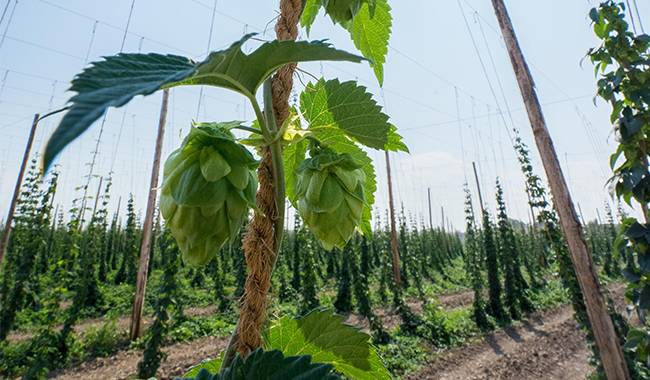
Hops are commonly used in gardens for vertical landscaping. In contrast to maidenhair vine or ivy, hops are not used as groundcovers. The rhizomes of hops can be placed under a wooden platform, for example near a pergola or barbecue area. You can make holes for the shoots or you can let them out at the edges.
This vine develops better in a semi-shady place. If the whole plant is left out in the open sun, on the other hand, the leaves of the hop plant will lighten and turn yellow, and in hot weather, they will wilt slightly and become more susceptible to disease and insect attack.
Hops are water-loving and handle drought poorly. Watering should be abundant, requiring about 20 liters of water per plant.
Hops prefer heavy clay and sandy soils with high iron and calcium content.
If living conditions are right, hop plants will grow very fast, up to 12inch (30cm) per day. This growth rate will be maintained until they start flowering.
Hops are grown in spring and autumn root quickly, but the first-year shoots are not strong and the root mass increases. Only if they have good-sized and large rootstocks with many long roots will hop be able to grow strongly already in early spring.
If the plant lacks sufficient nutrients in the soil, the root system will gradually spread and the vines will encroach on new areas. The main part of the root system is no more than 1.6 feet (0.5 m) deep, but individual roots can reach a depth of 10 feet (3 m) or more, allowing the plant to regenerate if necessary.
Each spring, the small shoots on the rhizomes “wake up”, but surprisingly, they soon produce strong, thick shoots that instantly and very precisely determine their own direction of movement towards the nearest support.
It is easiest to propagate this vine by root shoots, partial rhizomes, and cuttings, but not by seeds, a task best left to breeders.
From the second year onwards, more and more vertical shoots are formed, but it is best to leave only the two strongest ones, which experts call vines.
Hops begin to bear fruit in the third year.
Spring frosts up to 25°F (-4°C), the vine survives, but from the stress caused, it does not recover this year, its growth slows down and the harvest of cones will be insignificant.
In such a case, after the cold snap, it is best to cut all the shoots from the ground, carry out a lot of watering and soon new shoots will surely appear. All above-ground parts should be pruned before the first frost in autumn.
Almost all brewing hop varieties have red or greenish-red stems.
Zhatetsky hop is considered to be the best in the world. Its name comes from a small Czech town near which this hop variety was first discovered.
A very interesting variety is the English variety, or more precisely, the golding hops variety. These hops have large, lush, striped cones.
Dear Readers
Although you need to be very skilled with hops in the garden, especially in a small garden. But I’m sure you will have more fun than the problems with these amazing medicinal plants.Try to growing hops in your garden, you won’t regret it!




